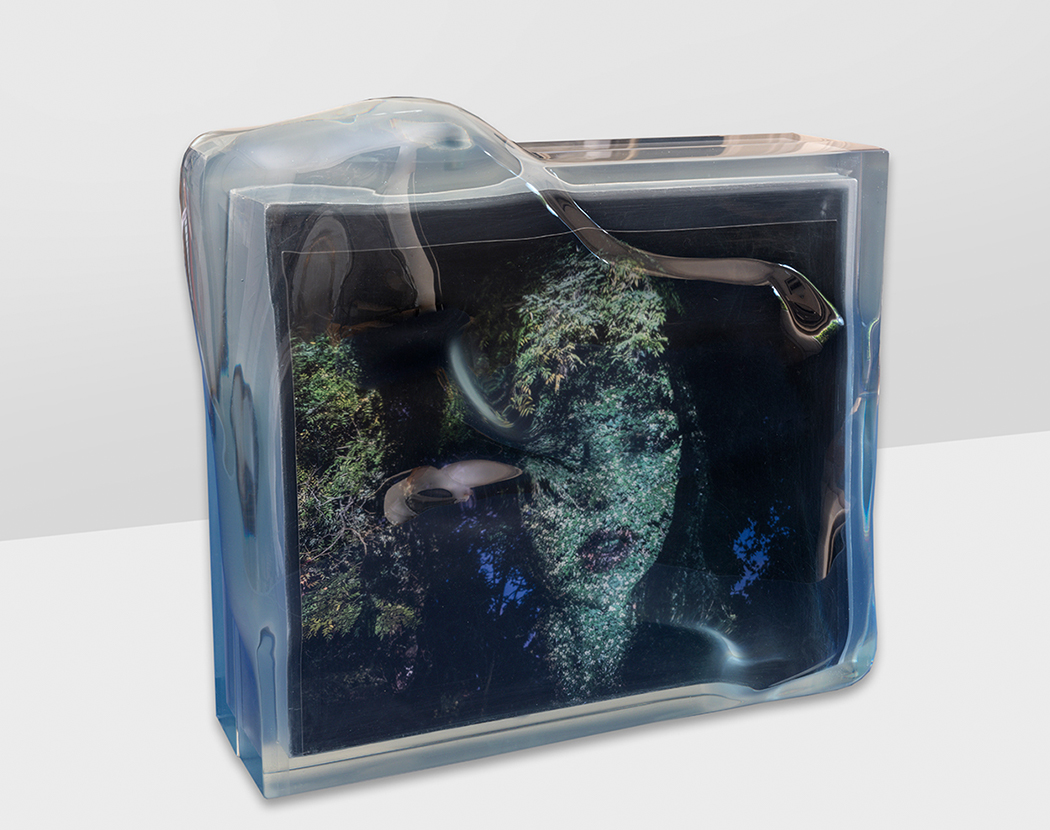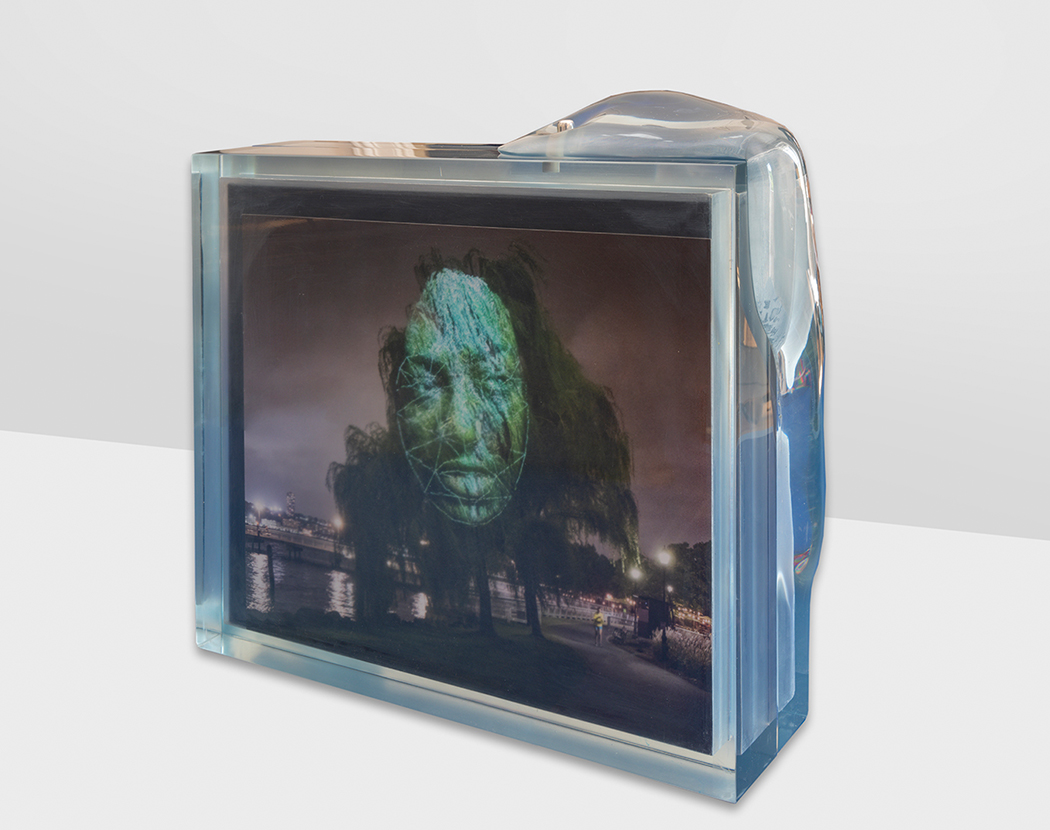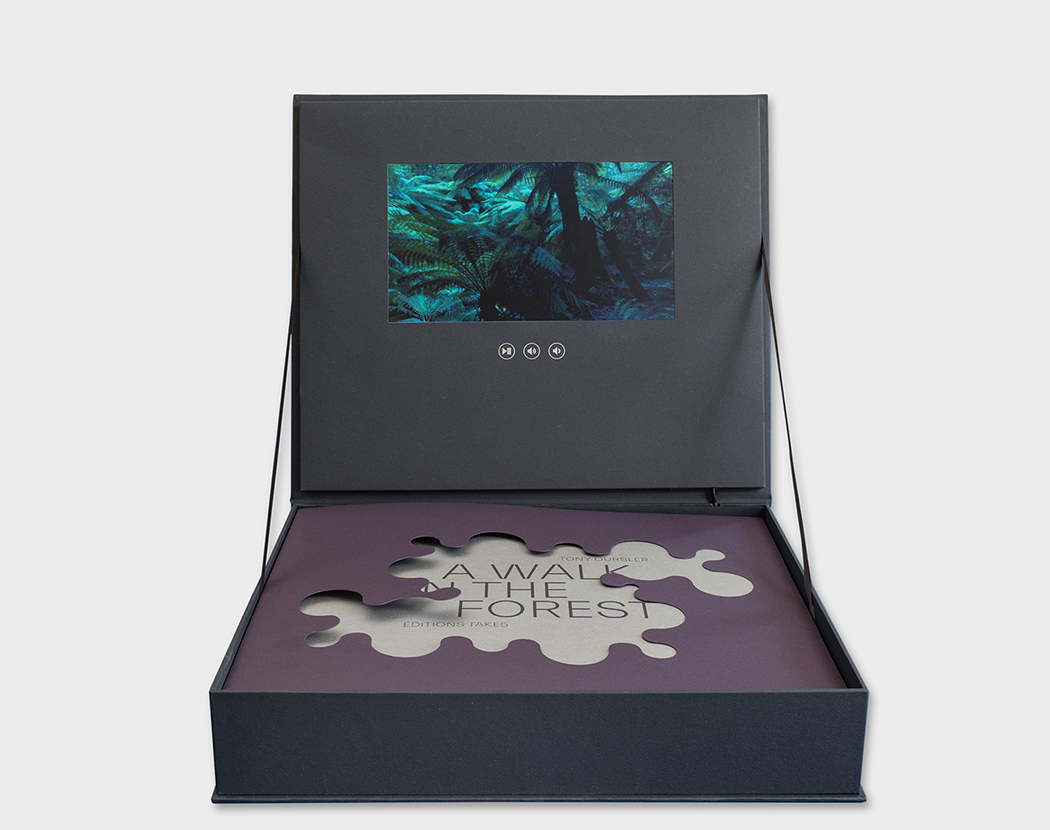
A Walk in the Forest
Published by éditions Take5, Geneva, in 2021under the editorial direction of Céline Fribourg.
Photographs: 14 original signed pigment prints by Tony Oursler.
A 15-minute video specially created by Tony Oursler for the book,
on an LCD screen with rechargeable battery incorporated in the box.
Text by Tony Oursler.
Graphics: Original typography, layout and cutouts drawn by
Studio Des Signes.
Screen printing and manual cutting.
Traycase designed by Germans Ermics,
sculpted in resin, and colored by Vincent de Rijk.
USB stick in engraved walnut containing the video.
An edition of thirty, numbered and signed by Tony Oursler.

There is nothing purely human, there is vegetal in all that is human, and the tree is at the origin of all experience.
—Emanuele Coccia
Since the early ’80s, Tony Oursler has made video art his field of choice. His visionary approach is to extract the moving image from the screen and to consider it in relation to its projection medium, creating truly immersive installations in which the viewers find themselves completely disoriented.
In 2000 in New York, Oursler created The Influence Machine, his first video work projected onto trees. Nineteen years later he repeated the experience in the garden of the Fondation Cartier, Paris, with the installation Eclipse. “When a solar eclipse passes over a tree, it is reflected on their leaves: looking at them from below, it creates a real optical system that fascinates me,” confides the artist. The result of this inspiration is a captivating staging of moving faces projected onto tree trunks and foliage, declaiming solemn, theatrical words questioning the human relationship with nature in contemporary society. The allegorical representation of the forest helps to signify the permanence of its empire, as a vital and regenerative force and also as a symbol.

There is nothing purely human, there is vegetal in all that is human, there is tree at the origin of all experience", writes philosopher Emanuele Coccia.
Since the early 90s, Tony Oursler has made video art his field of choice. His signature approach is to think of the image in relation to its projection medium, to create truly immersive installations in which the viewer finds himself completely off-center. In 2000, he created The Influence Machine in New York, his first video work projected onto trees. Nineteen years later, he repeated the experience in the garden of the Fondation Cartier with the installation Eclipse. "When a solar eclipse passes over a tree, it is reflected on their leaves: looking at them from below, it creates a real optical system that fascinates me", confides the artist. The result of this inspiration is a captivating staging of moving faces, declaiming theatrically solemn words about the place of man and nature in our contemporary society.

In the book A Walk in the Forest, Oursler invites us on a nocturnal stroll through the forest to encounter various “character-trees.” The photographs of these projections are as much portraits as they are phantasmagorical landscapes, reminiscent of Arcimboldo's Four Seasons (1563–73). By projecting moving faces onto the foliage and trunks of trees, the artist reminds us that the survival of humanity is integrally linked to the existence of trees and nature. The forest both precedes and succeeds man. Through his photographs and texts, Oursler becomes the translator and spokesman for trees, evoking the threats they face and underlining the incongruity of our attitude to them. The allegorical representation of the forest helps to signify the permanence of its empire both in nature and as a symbol.

The artist has created a 15-minute video for the book, shown on a screen inserted into the paper of the cardboard box. In this video, a succession of tableaux of correspondences between the visible and the invisible, the microcosm and the macrocosm, art, nature and science, transport us into a magical universe. Navigating between terrestrial, celestial, and supracelestial worlds, humanity is part of a whole, an infinite, dynamic, ever-changing metamorphosis. The humor and strangeness of Oursler's compositions underline the problems of our times with tenderness and melancholy: the metaphorical gaze of the artist gently hypertrophies the absurd, producing, as Roland Barthes formulated it, a subtle malaise even more penetrating than if the horror came from simple exaggeration or formal admonition.

In this back-and-forth movement from far to near, from ideal abstraction to physical materiality, Oursler invites the viewer to penetrate the vertiginous experience of the inconstancy of form and signifier. The artist is a magician who, as he strolls through the forest, plays with poetry, dreams, metaphor, the invention of language, enigma, cryptography, and the grotesque. Once the feeling of astonishment and amused amazement has passed, the images awaken our anxious conscience, in touch with a world in the grip of self-destruction.

Immersing themselves in the aesthetic of nature, the graphic-design studio Des Signes imagined a forest of pages anchored by a central paper trunk. And they created a font that "vegetalizes" the letters, which seem to grow organically across the page. A play of cut-out shapes recalls the shadows of the moon that sculpt the foliage at night.

To shelter this “spiritus phantasticus book,” Latvian-born designer Germans Ermics designed an intriguing tray case with a hybrid shape and subtle tones abstractly evoking certain features of the human face. This organic, almost liquid-looking container, molded and then slowly polished with the utmost care by the hands of Dutch resin designer Vincent de Rijk, evokes sap, water, and minerals. Each of the thirty tray cases has a slightly different hue, revealing the faces of these “character-trees” staring back at us through its shaded pigments.

 FR
FR